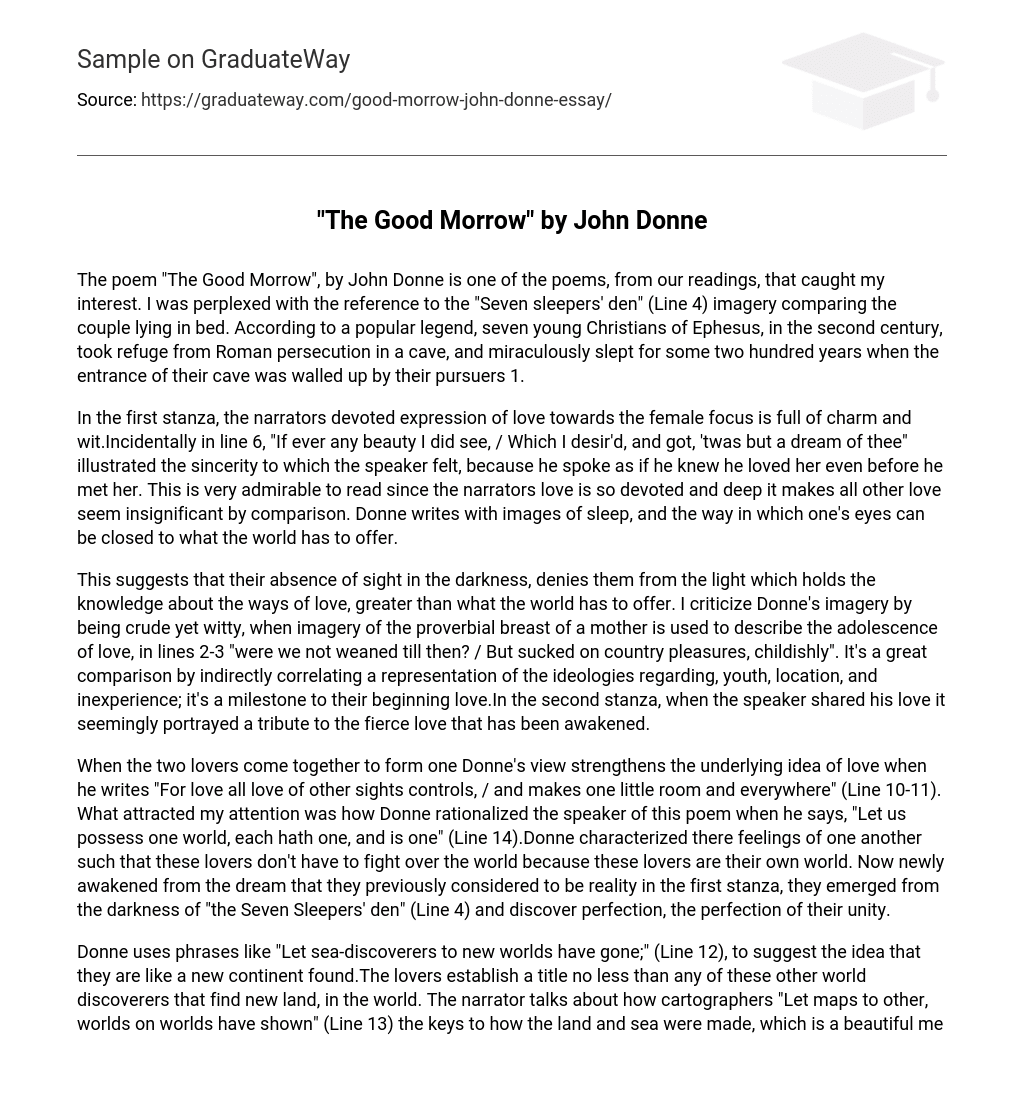The poem “The Good Morrow” by John Donne intrigued me. I was particularly fascinated by the reference to the “Seven sleepers’ den” (Line 4) imagery, which compares the couple lying in bed. In this comparison, the poet alludes to a popular legend from the second century about seven young Christians from Ephesus who sought sanctuary in a cave to escape Roman persecution. Miraculously, these individuals slept for approximately two hundred years until their pursuers sealed the entrance of the cave.
The first stanza of the poem showcases the narrator’s charming and witty expression of love towards the female subject. Line 6, “If ever any beauty I did see, / Which I desir’d, and got, ’twas but a dream of thee,” highlights the speaker’s profound sincerity, as he speaks as though he already knew he loved her before even meeting her. This level of devotion is truly admirable to read, as it diminishes all other forms of love in comparison. Donne incorporates images of sleep and closed eyes to depict how one can overlook what the world presents.
This suggests that not having sight in the dark prevents them from experiencing the enlightening knowledge of love, a knowledge greater than anything the world has to offer. I criticize Donne’s use of imagery for being crude yet clever. For example, in lines 2-3, he compares love’s adolescence to being weaned and sucking on childish pleasures. This comparison indirectly represents ideas about youth, location, and inexperience, marking the beginning of their love. In the second stanza, when the speaker expressed his love, it seemed to pay tribute to the passionate love that has been awoken.
The unity of the two lovers in Donne’s view strengthens the underlying idea of love. He writes, “For love all love of other sights controls, / and makes one little room and everywhere” (Line 10-11). What caught my attention was how Donne rationalized the speaker of this poem. He says, “Let us possess one world, each hath one, and is one” (Line 14). Donne characterizes their feelings for each other in a way that suggests these lovers don’t have to fight over the world because they are their own world. Now awakened from the dream they once believed to be reality in the first stanza, they emerge from “the Seven Sleepers’ den” (Line 4) and discover the perfection of their unity.
Donne employs phrases such as “Let sea-discoverers to new worlds have gone;” (Line 12) to convey the idea that these explorers resemble the discovery of a new continent. The lovers establish a significance akin to that of other explorers who uncover new territories in the world. The speaker references cartographers who “Let maps to other, worlds on worlds have shown” (Line 13), metaphorically suggesting how they reveal the origins of land and sea. This metaphor proves beautiful. In the third stanza, the speaker asserts that “Whatever dies was not mixed equally” (Line 19), implying that the lovers are entirely equal, and thereby enhancing the credibility of both the poem and the narrator. Now, he links their emotional love to factual evidence.
This is a lovely means of expressing the unending bond between them, ensuring that their love will never fade. The imagery in line 19 portrays the merging of their two souls in perfect harmony, akin to the fusion of the four elements – earth, air, fire, and water – to create a new entity. The equilibrium of two souls relies upon love and stability; the elemental fusion of their essence and the extent to which it is balanced will grant eternal life to their love.
Donne transitions from a dream-like state of sleep to reality in the third stanza of the poem. He asserts the facts with the statement, “My face in thine eye, thine in mine appears” (Line 15). Additionally, the speaker reinforces his integrity and the authenticity of his emotions by assuring his beloved with a sincere and genuine heart. Unlike other Shakespearean love poems, this poem is relatively easier to understand and it showcases a profound love between two individuals, symbolizing perfection. Donne’s cleverness and wit shine through in this brilliant piece.
Donne’s ingenious talent lies in his ability to use poetic symbols and images to evoke emotions and reveal deep feelings. In this poem, he presents a couple transitioning from a dreamlike reality to a sudden realization of sexual love. His revolutionary approach during the time this poem was written evokes envy, as it is rare to write with such passion. Reading his poem has provided me with a new perspective on love.





